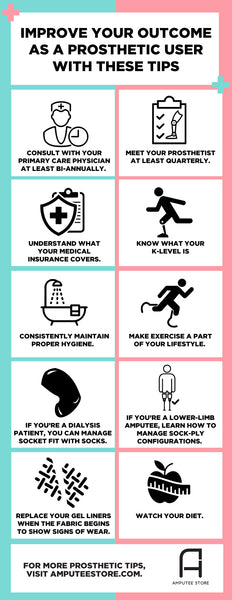10 Ways to Improve Your Prosthetic Outcome
Getting the most out of your prosthesis requires equal effort—50% from you, and 50% from your Prosthetist. Minor problems may occur from time to time, but communication and proper maintenance go a long way. Here are some tips on how to improve your outcome as a prosthetic user:

1. Consult with your primary care physician (PCP) at least bi-annually.
Set time aside for regular check-ins with your PCP to help you establish a relationship and keep your physician up-to-speed. Make sure you discuss the condition of both your residual limb and your prosthesis. This is the perfect opportunity for you to inform your PCP of any issues or prosthetic needs that need attention.
2. Know about your medical insurance coverage.
Understanding the terms of your insurance plan opens up the door to possibly buying a secondary coverage policy which helps you cover additional prosthetic expenses. It doesn’t matter if you're insured by Medicare, Medicaid, or other private insurance companies–you need to know what you should be spending on and where your money goes.
3. Know what your K-level is.
Defined by Medicare, the K-level indicates an amputee's mobility level. Knowing what your level is (range is from K-0 to K-4, with K-4 describing a very active individual) will help you and your Prosthetist understand the components needed in fabricating your prosthesis.
4. Nothing's wrong. Can I skip my appointment?
Having regular check-ups with your Prosthetist is necessary, even when you think everything's okay. Best to meet your Prosthetist at least quarterly (every 3 months) to make sure you're in good shape. If you feel the slightest kink in your prosthesis, contact your Prosthetist immediately and set up an appointment.
5. Consistently maintain proper hygiene.
Keeping your residual limb and prosthetic supplies clean, especially for lower-limb amputees, is highly important. Listen to your body–make sure your sound foot and leg do not cause you any issues in the long run. Take care of your skin and clean the inside of your liner daily. Dry skin and blisters may lead to infection if not properly taken care of.
6. Exercise and maintain an active lifestyle.
Staying immobile and sitting around may eventually compromise blood circulation and affect your lower limbs, especially for diabetic patients. Move around to help increase your circulation, and make sure you do it every day. A bit of exercise done consistently goes a long way for your health both physically and mentally.
7. Dialysis patients should manage socket fit with socks.
Residual limb volume may vary from day-to-day–more prosthetic socks are needed right after dialysis, while fewer socks are required as you approach your next session. Remember to take medication as prescribed to make sure your limb volume and socket fit are not compromised.
8. Lower-limb amputees should manage sock-ply configurations.
By maintaining consistent body weight and carefully observing your residual limb regularly, you'll be able to make sock adjustments as necessary. If you end up losing weight, that shouldn’t be a problem. Just let your PCP know if you need a smaller prosthetic socket during one of your appointments.
9. Replace your gel liners when necessary.
When gel liners thin out or the fabric begins to show signs of wear, it can cause skin breakdown; make sure you maintain your liners and replace them when needed. Check with your insurance provider regarding the frequency and quantity of gel liners they can cover.
10. Watch your diet.
If you have diabetes, it's crucial to maintain an overall healthy lifestyle. Dependency on multiple medications may lead to adverse long-term effects on your health and complicate your prosthetic outcome.











































































